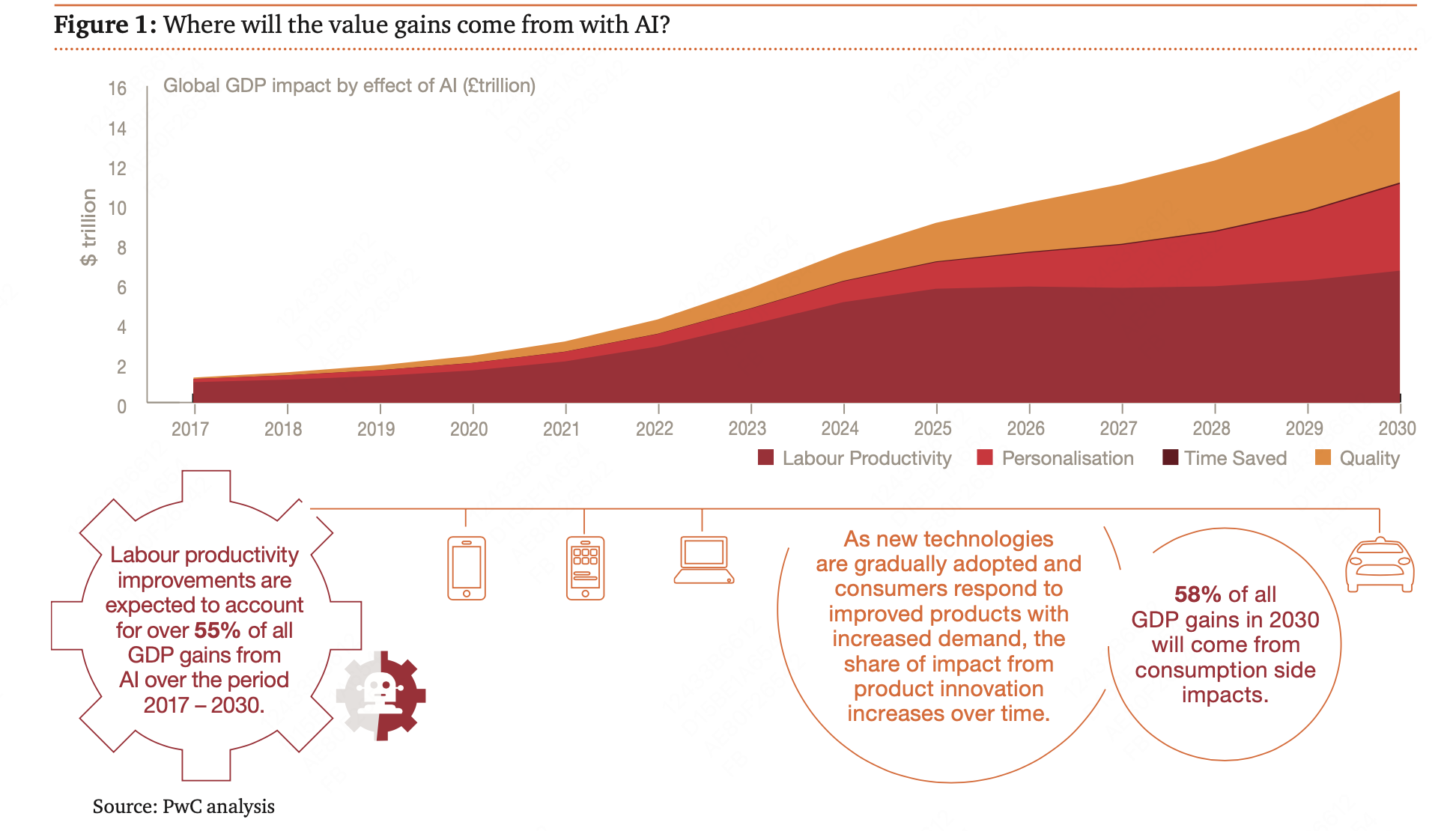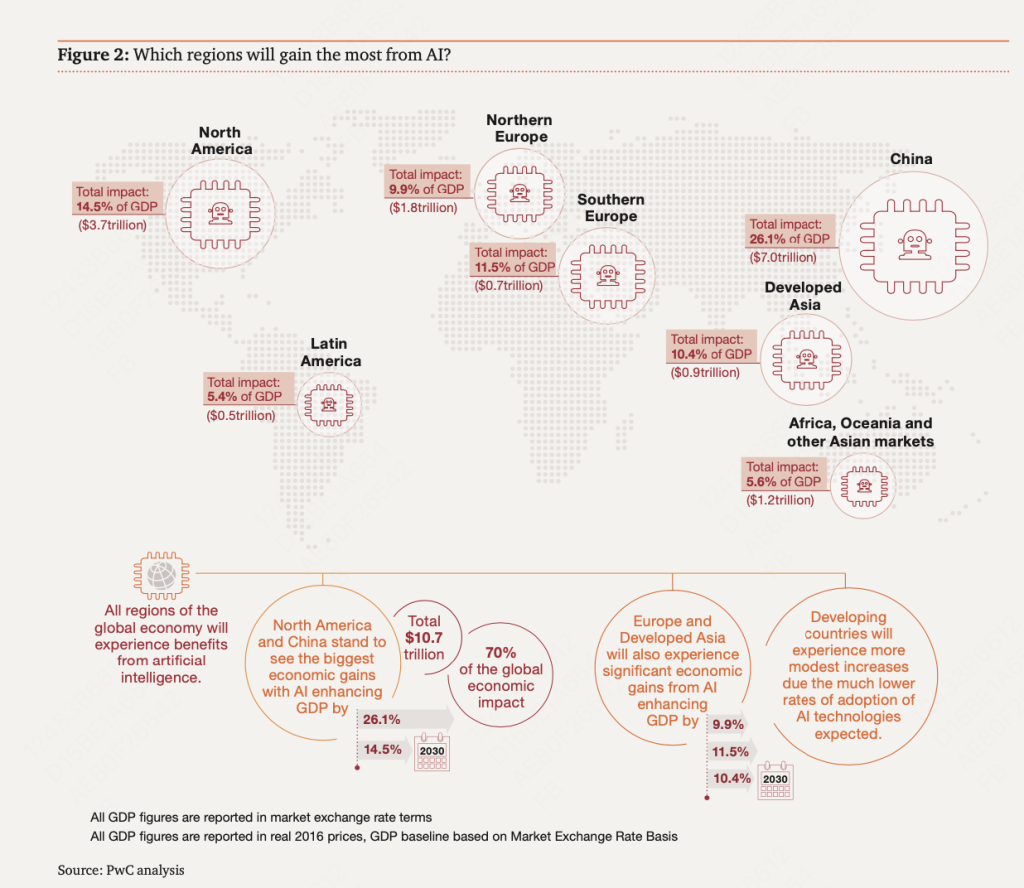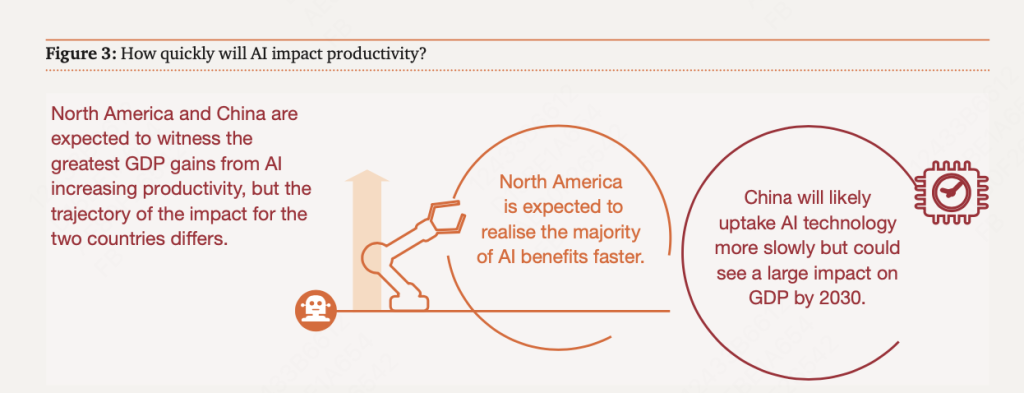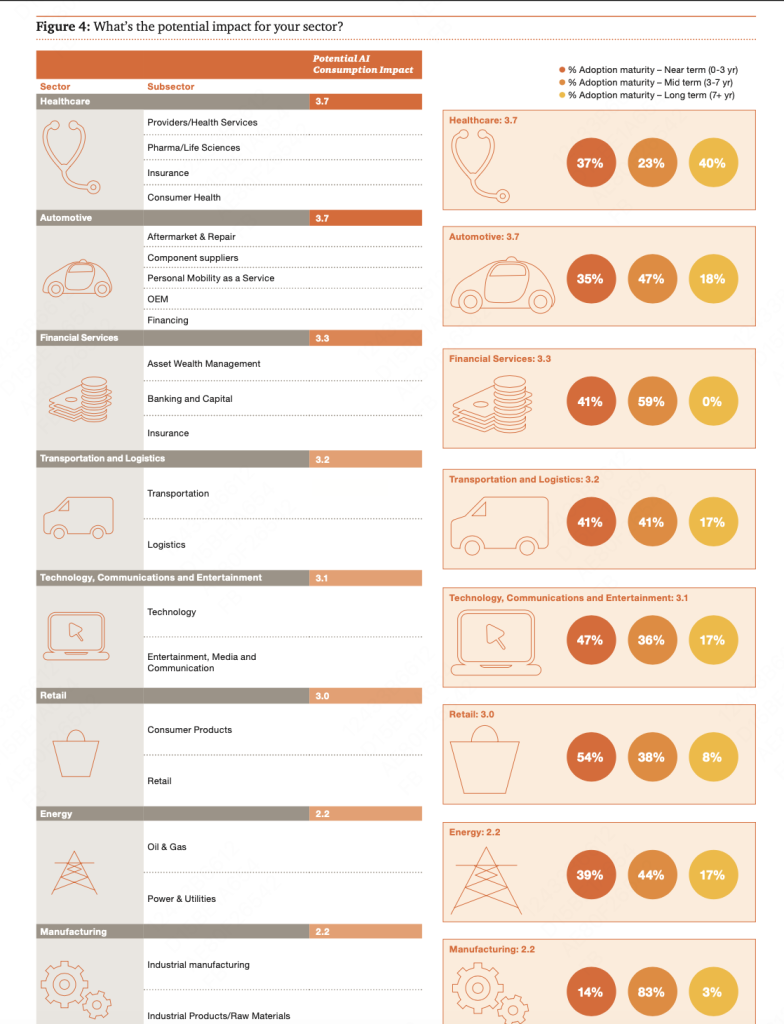- Publication: PricewaterhouseCoopers (PwC)
- Publication Date: 2017
- Organizations mentioned: Fraunhofer Big Data Alliance
- Publication Authors: Anand Rao, Gerard Verweij
- Technical background required: Medium
- Estimated read time (original text): 40 minutes (original text)
- Sentiment score: 80%, somewhat positive (100% being most positive)
The report by PwC analyzes the potential impact of artificial intelligence on the global economy, forecasting a significant increase in global GDP by 2030, primarily driven by gains in productivity, product quality, and consumption.
TLDR
Goal: This report by PricewaterhouseCoopers (PwC) aims to assess the potential impact of artificial intelligence (AI) on the global economy by 2030. The study was motivated by the burgeoning significance of AI in transforming various sectors, forecasting a potential increase in global GDP by 14% (an additional $15.7 trillion), making AI a pivotal factor in the rapidly evolving economic landscape.
Methodology:
- The methodology primarily involved comprehensive economic analysis, focusing on the potential GDP growth attributable to AI across different regions and sectors.
- It examined the impact of AI on productivity enhancements and consumption-side effects, differentiating between short-term and long-term economic uplifts.
- The report also considered the potential of AI in automating routine tasks, augmenting employee capabilities, and its effects on capital-intensive sectors like manufacturing and transport.
Key findings:
- Global Economic Impact: AI could contribute up to $15.7 trillion to the global economy by 2030, surpassing the current output of China and India combined.
- Out of this, $6.6 trillion could stem from increased productivity, and $9.1 trillion from consumption-side effects.
- Regional Benefits: Significant disparities in AI’s impact were noted across regions. For instance, China could see a 26% GDP increase, while North America could experience a 14% boost.
- Europe, Developed Asia, and other regions are also expected to benefit, though to a lesser extent.
- Impact on Labor Markets: AI is anticipated to reshape labor markets, especially by automating routine tasks, which can significantly affect the nature of work and employment patterns. This change is likely to necessitate a shift in skills, with increasing demand for technological, creative, and emotional intelligence capabilities.
- Growth in AI-Enabled Sectors: Industries like manufacturing and transport, due to their operational processes being highly susceptible to automation, stand to benefit enormously from AI-driven productivity enhancements. The report underscores that these sectors will likely witness some of the most pronounced changes and benefits from AI adoption.
- Influence on IoT (Internet of Things): AI is identified as a key factor in realizing the potential of IoT. The convergence of AI and IoT is expected to lead to the development of ‘smart’ machines and solutions.
- Consumer Behavior Shifts: The report predicts that AI will influence consumer behaviors, leading to increased demand for higher quality, customized products and services. This trend is expected to create a virtuous cycle of data collection, leading to better insights and further improvements in products and services.
- Data and AI Management: The effective use of AI technology requires a data-driven culture, focusing on both societal and ethical implications, building stakeholder trust, and ensuring unbiased, transparent AI systems.
Recommendations:
- Strategic Evaluation: Businesses should assess the technological developments and competitive pressures AI brings to their sectors, identifying operational pain points that AI could address.
- Prioritization and Response: It is crucial to determine strategic responses to AI, including assessing different AI options to align with business goals and readiness for change.
- Talent and Culture: Investing in the right talent and fostering a culture attuned to AI and data analytics is essential. This includes preparing for a hybrid workforce where AI and humans work side-by-side.
- Ethical Considerations: Businesses should consider the societal and ethical implications of AI, striving for solutions that are unbiased and transparent.
- Long-term Planning: Companies should focus on long-term training and development in emerging areas like data science and robotics, and value skills that cannot be replicated by machines, such as creativity and emotional intelligence.
Thinking critically
Implications:
- Economic Redistribution and Inequality: The report’s findings suggest a significant increase in global GDP driven by AI, with the largest gains in developed regions like North America and China. If these predictions hold, we might see a widening economic gap between countries with advanced AI capabilities and those without. This could lead to increased global inequality, as countries lagging in AI adoption might find it challenging to compete economically and attract investments. Conversely, if organizations globally do not adopt AI, there could be a stagnation in economic growth and innovation, hindering overall global progress.
- Labor Market Transformation: The automation of routine tasks and the demand for new skill sets, as highlighted in the report, imply a major shift in the labor market. There would be a growing need for re-skilling and up-skilling of the workforce to adapt to AI-driven changes. This could lead to short-term job displacement but potentially offer long-term benefits through higher-value job creation. If organizations fail to adapt to these changes, they might face talent shortages and decreased competitiveness.
- Ethical and Societal Challenges: The adoption of AI as per the report’s recommendations requires addressing ethical considerations, including biases in AI systems and the societal impact of automation. Successful integration of AI in businesses and societies hinges on addressing these challenges to ensure equitable and responsible use of AI. Neglecting these aspects could lead to public distrust in AI, potential misuse of technology, and socio-political tensions.
Alternative Perspectives:
- Methodological Critiques: While the report provides an optimistic view of AI’s economic impact, it may be critiqued for potentially overestimating AI’s capabilities and underestimating the challenges in implementation. There is a risk that the report’s positive predictions might overlook the complexities involved in AI integration, such as data privacy concerns, regulatory hurdles, and the actual readiness of organizations to adopt advanced AI solutions.
- Economic Overreliance: Another perspective might argue against the heavy reliance on AI for economic growth, emphasizing the risk of creating an economy overly dependent on technology, potentially vulnerable to cybersecurity threats and AI system failures. This view would advocate for a more balanced approach, combining AI with human oversight and traditional economic drivers.
- Social and Ethical Concerns Overlooked: The report focuses on the economic benefits and business strategies related to AI, but critics may argue that it does not sufficiently address the broader social and ethical implications of widespread AI adoption. Issues such as job displacement, privacy concerns, and AI ethics need more comprehensive exploration beyond just business and economic contexts.
AI Predictions:
- Growth in AI-Driven Healthcare and Retail: Based on the report’s findings, there will likely be significant advancements and investments in AI within healthcare and retail sectors. These industries could see innovations in personalized care, diagnostics, customer service, and supply chain management driven by AI.
- Increased AI Regulation and Standardization: Given the substantial economic and social impact predicted by the report, there may be a rise in global efforts to regulate AI and establish international standards for its ethical and responsible use.
- Hybrid Workforce Models Becoming Norm: The prediction of AI augmenting human capabilities suggests a future where hybrid workforce models become the norm. This would involve AI and humans working in tandem, with AI handling routine tasks and data analysis, while humans focus on creative, strategic, and interpersonal aspects of work.
Glossary
- Large-scale Machine Learning: Design of learning algorithms, as well as scaling existing algorithms, to work with extremely large data sets.
- Deep Learning: Model composed of inputs such as image or audio and several hidden layers of sub-models that serve as input for the next layer and ultimately an output or activation function.
- Natural Language Processing (NLP): Algorithms that process human language input and convert it into understandable representations.
- Collaborative Systems: Models and algorithms to help develop autonomous systems that can work collaboratively with other systems and with humans.
- Computer Vision (Image Analytics): The process of pulling relevant information from an image or sets of images for advanced classification and analysis.
- Algorithmic Game Theory and Computational Social Choice: Systems that address the economic and social computing dimensions of AI, such as how systems can handle potentially misaligned incentives, including self-interested human participants or firms and the automated AI-based agents representing them.
- Soft Robotics (Robotic Process Automation): Automation of repetitive tasks and common processes such as IT, customer servicing and sales without the need to transform existing IT system maps.







 Join hosts Anthony, Shane, and Francesca for essential insights on AI's impact on jobs, careers, and business. Stay ahead of the curve – listen now!
Join hosts Anthony, Shane, and Francesca for essential insights on AI's impact on jobs, careers, and business. Stay ahead of the curve – listen now!


